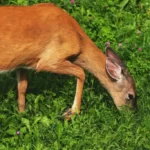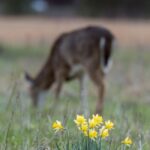Camellias, renowned for their elegant blooms and lush evergreen foliage, hold a special place in the hearts of gardeners and landscaping enthusiasts. However, in regions inhabited by deer, concerns often arise regarding potential damage to these cherished shrubs. The central question that frequently looms is: Do deer eat camellias? In this article, we embark on a journey to unravel the complexities of deer behavior and their interactions with camellia plants. By gaining insights into deer behavior, we can better address the challenges of coexisting with these graceful yet sometimes voracious herbivores in our gardens and landscapes.
- Made in USA
- UV Treated
- 600-650 lb breaking load
- Mesh: 1.77 in x 1.97 in
- Exclusive rounded tensile design
Deer Behavior
Understanding the behavior of deer is fundamental when assessing their potential impact on plants like camellias. Deer, primarily herbivores, exhibit feeding habits influenced by various factors, including season, region, and food availability. Here are key aspects of deer behavior related to their dietary preferences:
- Seasonal Variation: Deer’s feeding behavior can vary significantly throughout the year. During the spring and summer, when lush vegetation is abundant, they often graze on a wide range of plants, including shrubs and young trees. However, in the fall and winter, when natural forage becomes scarcer, they may resort to browsing on woody plants like camellias.
- Regional Differences: Deer populations and their dietary preferences can differ by region. Areas with high deer populations may experience more significant damage to landscaping plants, including camellias.
- Dietary Preferences: Deer have preferences for certain plants over others. They often favor tender shoots, leaves, and buds. However, their dietary choices can change based on local food availability and pressures from predators.
- Adaptability: Deer are adaptable creatures, and their dietary choices can shift based on the availability of alternative food sources in the vicinity.
By delving into the nuances of deer behavior, we can gain a deeper understanding of the factors that influence their interactions with camellias and develop strategies to protect these cherished plants from potential deer damage.
Camellias: Overview
Before we delve into the question of whether deer eat camellias, let’s first acquaint ourselves with these captivating plants. Camellias are a diverse group of evergreen shrubs and small trees belonging to the Camellia genus. Here’s an overview of camellia plants:
- Appearance: Camellias are known for their glossy, dark green leaves and exquisite, often waxy flowers. The flowers come in a variety of forms, including single, semi-double, and double, and can range in color from pure white to shades of pink, red, and even lavender.
- Varieties: Camellias encompass numerous species and cultivars, each with its unique characteristics. Some well-known species include Camellia japonica, Camellia sasanqua, and Camellia reticulata, among others.
- Blooming Season: Depending on the species and variety, camellias bloom at different times of the year. While some bloom in the winter and early spring, others may grace the garden with their flowers in the fall.
- Common Uses: Camellias are highly valued for their ornamental beauty and are frequently used as focal points in gardens, foundation plantings, or hedges. They are also popular for their use in floral arrangements.
- From late fall to spring, ‘Jury’s Yellow’ bears a succession of creamy-white flowers, each with a central ruff of pale yellow “petaloids.”
- This large, broadleaf evergreen shrub has a dense, upright habit and attractive Smooth gray branches furnished with Oval, Glossy, medium-green leaves
- Prefers slightly acidic soils with filtered sun to shade. Great for use in shade gardens, Woodland plantings, as specimen plants, or in large container gardening. Evergreen
- mature height ( 8-12 feet ) — mature width ( 4-8 feet ) — exposure ( full shade to partial shade ) — hardiness zones ( 7-9 )
- Ships in a Quart pot — we can not guarantee flowers at time of purchase
Do Deer Eat Camellias?
The question of whether deer eat camellias is one that concerns many gardeners. The answer depends on a variety of factors, including deer behavior and local conditions:
- Deer Pressure: Areas with high deer populations may experience more frequent deer browsing on landscaping plants, including camellias.
- Seasonal Variation: Deer are more likely to nibble on woody plants like camellias during the fall and winter months when their natural forage becomes scarcer.
- Plant Age: Young camellia plants with tender shoots and foliage may be more susceptible to deer browsing than mature, established plants with tougher foliage.
- Local Food Availability: The presence of alternative food sources in the vicinity can also influence deer’s interest in camellias. If other preferred plants are readily accessible, they may be less inclined to browse on camellias.
- Deterrents: Some gardeners use deer deterrent methods such as fencing, repellent sprays, or companion planting with deer-resistant species to protect their camellias from deer damage.
In summary, while camellias are not typically considered a preferred food source for deer, deer behavior and local conditions can influence whether they are at risk of browsing. Gardeners in deer-prone areas should remain vigilant and consider protective measures to ensure the health and beauty of their camellia plants.
Strategies for Protecting Camellias
Protecting camellias from potential deer damage requires proactive strategies to safeguard these exquisite plants. Here are some effective measures that gardeners can employ:
- Fencing: Installing deer-resistant fencing around your camellias can be one of the most reliable methods of protection. Ensure that the fencing is tall enough and properly secured to deter deer from reaching the plants.
- Repellent Sprays: Applying deer repellent sprays to the foliage of your camellias can help deter deer by emitting odors that are unpleasant to them. Reapply the repellent as directed, especially after rain.
- Companion Planting: Surround your camellias with plants that are known to be deer-resistant. The presence of less appealing food sources nearby may discourage deer from venturing closer to your camellias.
- Pruning and Trimming: Regularly prune and trim your camellias to remove lower branches and foliage. This not only enhances their aesthetics but can also make them less accessible to deer.
- Motion-Activated Devices: Motion-activated sprinklers or noise-making devices can startle and deter deer when they approach your camellias.
- Tough durable deer netting; Protects landscape and crops from deer and other animals
- Economical, lightweight deer protection; Black UV-resistant deer netting
- Reusable mesh deer fence; Stops deer and other animals from eating shrubs, berries, and vegetables
- Easy to use roll of deer fence netting; Attaches easily to posts and trees
- Do it yourself deer netting for protecting trees, shrubs, orchards and crops
Alternative Landscaping Choices
For gardeners seeking alternative landscaping options or living in areas with high deer populations, exploring deer-resistant plants and landscaping choices can be a practical approach. Here are some alternatives to consider:
- Rhododendrons (Rhododendron spp.): Rhododendrons offer a stunning array of colorful blooms and are often less attractive to deer.
- Azaleas (Rhododendron spp.): Azaleas are closely related to rhododendrons and come in various sizes and flower colors.
- Lavender (Lavandula spp.): Lavender not only adds fragrance to your garden but is also known for its resistance to deer browsing.
- Barberry (Berberis spp.): Barberry shrubs, with their thorny branches, are typically unappealing to deer.
- Native Plants: Exploring native plant species that have evolved to thrive in your region can be a rewarding choice. Many natives are naturally deer-resistant.
- It is fully rooted in the soil and can be planted immediately upon arrival, weather permitting. Planting and how-to-care instructions will arrive with shipment.
- For best results, plant in USDA Zones 5-7. Mature height is 4-5ft, mature spread is 4-5ft.
- Deep red flowers against its glossy, dark green foliage provide quite the sight in the landscape.
- Compact growth habit, evergreen.
- Grows well in partial shade.
Conclusion
In conclusion, the compatibility of camellias with deer depends on several factors, including deer behavior, local deer populations, and the availability of alternative food sources. While camellias are not typically considered a preferred food source for deer, gardeners in deer-prone areas should take precautions to protect these cherished plants.
By implementing protective measures like fencing, repellents, and companion planting, you can minimize the risk of deer damage and ensure the continued beauty of your camellias. Exploring alternative landscaping choices and deer-resistant plants can provide you with a range of options to create a resilient and aesthetically pleasing garden.
Ultimately, with careful planning and proactive strategies, you can strike a balance between enjoying the beauty of camellias and coexisting harmoniously with the deer that share your natural environment.








